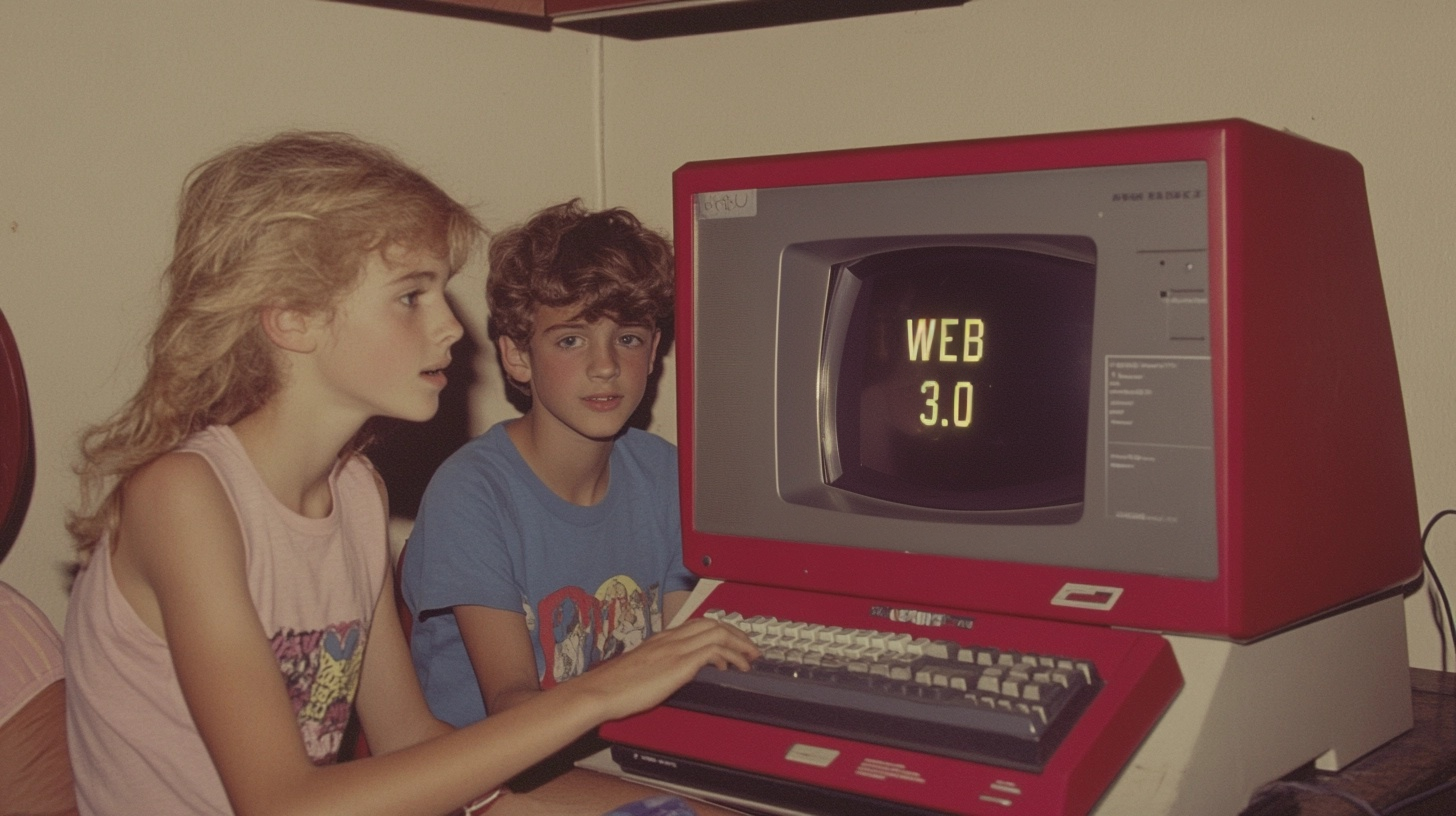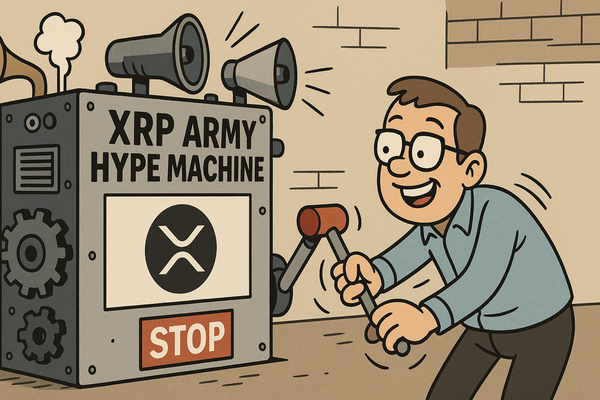Beyond the Hype: Seeing Tomorrow's Giants in Today's Awkward Tech Adolescence

Ever found yourself squinting at a technological breakthrough, thinking, "This is it? This clunky, complicated mess is what everyone's been raving about?"
You're not alone. And you might just be making the same mistake that has caused countless investors, companies, and everyday folks to miss out on some of the biggest wealth-creation opportunities in history.
Let me tell you why focusing too much on what a technology is right now—rather than what it could become—might be the most expensive mistake you'll ever make.
The Awkward Teenage Years of Revolutionary Tech
New technologies rarely arrive fully formed and user-friendly. They stumble into the world like newborn giraffes: gangly, uncoordinated, and confusing to look at. Blockchain, cryptocurrency, and artificial intelligence are all going through their own versions of technological puberty.
And just like teenagers, they're simultaneously full of promise and painfully awkward.
Blockchain transactions are slow. Crypto wallets are confusing. AI hallucinates facts and requires prompt engineering skills that feel like speaking an alien language. The interfaces are unintuitive, the learning curves steep, and the practical use cases sometimes feel forced.
But here's the thing about technological adolescence: it passes.
The Pattern of Dismissal (And Regret)
History is littered with smart people who couldn't see past the current limitations of emerging technologies:
"This 'telephone' has too many shortcomings to be seriously considered as a means of communication." — Western Union internal memo, 1876
"The internet will catastrophically collapse in 1996." — Robert Metcalfe, founder of 3Com and co-inventor of Ethernet
"There is no reason anyone would want a computer in their home." — Ken Olsen, founder of Digital Equipment Corporation, 1977
These weren't stupid people. They were experts who couldn't imagine how rough prototypes would evolve into world-changing technologies.
They focused on what was instead of what could be.
The Amazon Dirt Road
When Amazon launched in 1995, it was just an online bookstore with a bare-bones website. The interface was basic, selection limited, and the idea of ordering products over the internet seemed strange to most people.
Early investors saw past the initial limitations. They realized Amazon wasn't just selling books—it was building infrastructure for a new way of shopping.
Amazon's stock is up roughly 100,000% since its IPO. But that journey wasn't obvious when the company was just an ugly website selling books from Jeff Bezos's garage.
What if Amazon had been judged solely on its initial implementation rather than its vision?
The Vision-Reality Gap
This pattern repeats itself because of something I call the "Vision-Reality Gap." It's the chasm between what a technology is today and what it will eventually become.
The bigger this gap, the greater the potential opportunity—and the harder it is for most people to see it.
Consider early mobile phones. They were bulky, expensive, had terrible battery life, and could only make calls. The Vision-Reality Gap was enormous. Those who could bridge that gap in their minds—who could see that these clunky devices would eventually become the pocket supercomputers we carry today—positioned themselves for enormous returns.
Navigating Today's Vision-Reality Chasms
So where are today's Vision-Reality Gaps? Let's look at three technologies that are currently in their awkward phase but hold immense potential:
1. Blockchain and Cryptocurrency
Current Reality: Slow transactions, high energy consumption, complicated wallets, volatile prices, and a sea of scams.
Future Vision: A financial system with dramatically lower friction, where value transfers are as easy as sending an email, where middlemen don't extract 3% from every transaction, and where financial services are accessible to anyone with an internet connection.
Remember when sending an email attachment larger than 10MB was practically impossible? Remember when making an international call cost $3 per minute? Technological progress eventually crushed those limitations. The same will happen with blockchain's current constraints.
2. Artificial Intelligence
Current Reality: Hallucinations, bias problems, complicated interfaces, and systems that require expert prompt engineering to produce useful results.
Future Vision: AI assistants that understand context, can perform complex cognitive tasks, enable natural human-computer interaction, and augment human capabilities across virtually every field.
We're obsessing over whether today's AI can reliably write an email without making things up. That's like judging the future of automobiles based on the Model T's top speed.
3. Virtual and Augmented Reality
Current Reality: Bulky headsets, limited content, motion sickness, and experiences that feel more like tech demos than compelling products.
Future Vision: A seamless blend of physical and digital worlds that transforms how we work, learn, connect, and entertain ourselves.
The gap is enormous here, but so is the potential. Just as smartphones evolved from ridiculous luxuries to essential tools, AR/VR will evolve from awkward novelties to transformative platforms.
How to Develop Vision-Reality Gap Thinking
So how do you train yourself to see past current limitations and spot the next big thing? Here are four approaches:
1. Study the Evolution Patterns of Previous Technologies
Look at how the internet, smartphones, or social media evolved from their clunky beginnings. What limitations seemed insurmountable but were eventually solved? What assumptions about user behavior proved wrong?
For example, people once thought nobody would put personal information online. Now we share our lives on Instagram.
2. Identify the Core Benefits, Not the Implementation
Ask: What fundamental human need or desire does this technology address, regardless of its current form?
Early file-sharing services like Napster were legally problematic and clunky. But they revealed a core desire: instant access to any music. That core benefit eventually emerged in a polished, legal form as Spotify.
3. Look for Infrastructure Plays
Often, the biggest opportunities aren't in the flashy consumer applications but in the picks-and-shovels businesses building critical infrastructure.
During the internet boom, many consumer websites failed, but companies building the backbone of the internet—like Cisco—thrived. Who's building the essential infrastructure for tomorrow's blockchain applications or AI systems?
4. Watch Behavior at the Edges
Pay attention to what early adopters are willing to tolerate to use new technology. If people are putting up with significant inconvenience to use something, that signals strong underlying demand.
Early Bitcoin users navigated complicated exchanges and wallet software because they saw value that outweighed the hassle. That's a powerful indicator.
The Patience Premium
Vision-Reality Gap thinking isn't just about identifying potential; it's also about timeframes.
Transformative technologies take time to mature. The internet was conceived in the 1960s, developed in the 1970s, standardized in the 1980s, commercialized in the 1990s, and only reached its current form in the 2000s and beyond.
This timeline means that even if you correctly identify a world-changing technology, you need patience. The "patience premium" is the extra return earned by those willing to endure the awkward teenage years of a technology.
As Warren Buffett says, "The stock market is a device for transferring money from the impatient to the patient."
Real-World Vision-Reality Success Stories
Let's look at some people who mastered Vision-Reality Gap thinking:
Steve Jobs and the Graphical User Interface: When Jobs visited Xerox PARC in 1979, he saw a clunky, slow graphical interface. While others focused on its limitations, Jobs saw the future of computing. The result? The Macintosh, which revolutionized personal computing.
Marc Andreessen and the Web Browser: When Andreessen helped create Mosaic (the first popular web browser) in 1993, the web was text-heavy, slow, and limited. He saw past those constraints to envision a world where the browser would be our gateway to information, entertainment, and commerce.
Vitalik Buterin and Ethereum: When Buterin conceived Ethereum in 2013, blockchain was synonymous with Bitcoin and digital currency. He envisioned blockchain as a platform for any type of application. Despite years of technical challenges, that vision is now driving a new generation of decentralized applications.
Avoiding Vision-Reality Gap Traps
While thinking beyond current limitations is powerful, it comes with risks:
The Perpetual Tomorrow Problem: Some technologies remain permanently stuck in the "promising future" phase. Commercial nuclear fusion has been "20 years away" for the past 60 years.
The Infrastructure Mirage: Sometimes the necessary supporting infrastructure takes decades to build, delaying the vision far beyond initial expectations.
The Human Behavior Barrier: Technology that requires significant behavior change faces extra hurdles, regardless of its potential benefits.
To mitigate these risks, look for steady progress on key technical challenges, growing developer ecosystems, and early signs of mainstream adaptation.
Building Your Vision-Reality Portfolio
So how might you apply this thinking to your own investment or career decisions?
- Allocate a portion of your investment portfolio to Vision-Reality Gap opportunities, recognizing they are high-risk, potentially high-reward positions with long time horizons.
- Develop skills at the intersection of current expertise and emerging technology. If you're in finance, learn about decentralized finance. If you're in content creation, explore AI-assisted creativity.
- Experiment as a user, even when the experience is frustrating. Using early versions of technology builds intuition about its potential and limitations.
- Build a network of forward-thinking peers who can help you separate genuine Vision-Reality Gaps from mere hype.
The Ultimate Edge
The greatest advantage in investing and business isn't access to information—we all have more information than we can handle. The advantage comes from having a different time horizon and perspective than the market.
While others judge technologies by today's standards, the Vision-Reality Gap thinker asks: "What could this become when the current limitations are solved?"
That question—consistently applied with patience and discernment—is worth its weight in Bitcoin. Or whatever comes next.
Because remember: Every technology that changed the world once looked like a novelty or fad to most people. The trick is seeing the successfully developed adult hiding in the awkward teenager.
WANT TO LEARN MORE? LET'S TALK!
I manage a private crypto fund that works with accredited and institutional investors. If you’re considering exposure for your portfolio, looking to learn more, or exploring strategic partnerships as an allocator or advisor, I'd love to connect!
🚀 Send me an email or a message on LinkedIn.
Disclaimer: The information provided in this blog is for informational and educational purposes only and should not be considered financial, investment, or legal advice. Do your own research and consult a professional—your money, your responsibility.




